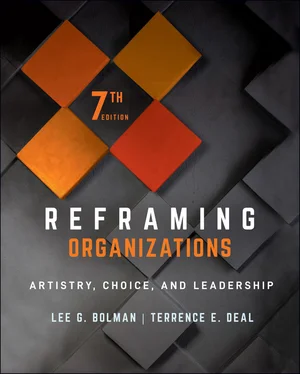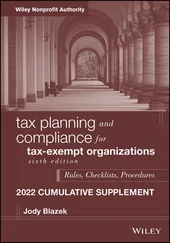Lee's six children—Edward, Shelley, Lori, Scott, Christopher, and Bradley—and three grandchildren (James, Jazmyne, and Foster)—all continue to enrich his life and contribute to his growth. Terry's daughter Janie, a chef, has a rare talent of almost magically transforming simple ingredients into fine cuisine. Special mention also goes to Terry's deceased parents, Bob and Dorothy Deal. Both lived long enough to be pleasantly surprised that their oft‐wayward son could write a book. Equal mention is due to Lee's parents, Eldred and Florence Bolman.
We again dedicate this book to our wives, who have more than earned all the credit and appreciation that we can give them. Joan Gallos, Lee's spouse and closest colleague, combines intellectual challenge and critique with support and love. She has been an active collaborator in developing our ideas, and her teaching manual for previous editions has been a frame‐breaking model for the genre. Her contributions have become so integrated into our own thinking that we are no longer able to thank her for all the ways that the book has gained from her wisdom and insights.
Sandy Deal's psychological training enables her to approach the field of organizations with a distinctive and illuminating slant. Her successful practice produces examples that have helped us make some even stronger connections to the concepts of clinical psychology. She is one of the most gifted diagnosticians in the field, as well as a delightful partner whose love and support over the long run have made all the difference. She is a rare combination of courage and caring, intimacy and independence, responsibility, and playfulness.
To Joan and Sandy, thanks again. As the years accumulate (rapidly), we love you even more.
Lee G. Bolman
Brookline, Massachusetts
Terrence E. Deal
San Luis Obispo, California
January, 2021
PART ONE Making Sense of Organizations
Chapter 1 Introduction: The Power of Reframing
Donald Trump's presidency was distinctive for his outsized personality, raucous rallies, fearsome Twitterstorms, and stunning iconoclasm. It was also unorthodox from a management perspective, a feature that generated less media attention but affected everything the Trump administration tried to do. From his experience of running a family business, Trump brought a deeply ingrained preference for patriarchy rather than bureaucracy, for entrepreneurial flexibility rather than structural constraint, and for lieutenants whose loyalty mattered more than their experience or expertise (Blair, 2018). He created a structure much like that of a boisterous family, with Trump as a dominant father figure whose attention and favor everyone else fought to get.
Traditionally, presidents have relied on their chiefs of staff to bring a modicum of order and discipline to operations that are chronically hectic and complex. Trump's first chief of staff, Reince Priebus, lasted only six months, during which he struggled to control both his boss and his staff. He was “widely viewed as weak and ineffective,” but “hardly got the chance to operate as an effective chief of staff” (Prokop, 2017), because he was hobbled by more powerful informal players like Trump consigliere Steve Bannon and Trump's son‐in‐law Jared Kushner.
Trump tried to rein in the chaos and infighting of the Priebus era by appointing a retired marine general, John Kelly, as his next chief of staff, but the buttoned‐down general and the mercurial president were not a match made in heaven. Kelly set out to bring coherence and a semblance of military discipline to the cacophony of voices that vied for the president's attention. He announced a hierarchical system requiring all staff to go through him before seeing the president, but that was alien to the president's free‐wheeling style. As a former official in the Bush administration noted, “The notion of a chain of command is gone” (Baker, 2017).
Kelly lasted 18 months in the job, longer than many skeptics expected, before leaving in the wake of media reports that he and the president were no longer on speaking terms. After his departure, Trump's subsequent chiefs (Mick Mulvaney and Mark Meadows) were loyalists with limited inclination or ability to contain the president's impulses.
White House turmoil reached a new high after Joe Biden was declared the winner of the 2020 presidential election. Some of Trump's most committed supporters found that he was eager to listen to any conspiracy theory that reinforced his preferred narrative that he had “won by a landslide” (Barry and Frenkel, 2021). Trump ignored advisors who encouraged him to acknowledge Biden's victory. Instead, he devoted almost all his attention to a quixotic battle to overturn the election results. A tragic climax came on January 6, 2021, when Trump's “Rally for America” triggered a mob to march down Pennsylvania Avenue and to invade the halls of Congress, producing terror, vandalism, and five deaths.
A few weeks before the rally, Trump had tweeted to his supporters, “Big protest in D.C. on January 6th. Be there, will be wild!” At the event, he gave an hour‐long, barn‐burner of a speech that extolled his achievements, insisted that the election had been stolen, and told his audience they needed to be strong to “stop the steal.” Near the end of the address, he exhorted the crowd, “And we fight. We fight like Hell and if you don't fight like Hell, you're not going to have a country anymore” (Jacobo, 2021). The crowd apparently took him at his word and became a pugnacious mob, armed and looking for trouble. The only thing in their way was an undermanned Capitol Police Force.
The federal government has the capacity to deploy massive security forces in the District of Columbia, but it takes substantial planning and coordination. Security assets in the region are widely dispersed across the District of Columbia's metropolitan police force, the neighboring states of Maryland and Virginia, and multiple federal departments, including Defense, Justice, and Homeland Security. That was a problem in the run‐up to the president's “Save America” rally:
Two days before Congress was set to formalize President‐elect Joe Biden's victory, Capitol Police Chief Steven Sund was growing increasingly worried about the size of the pro‐Trump crowds expected to stream into Washington in protest. To be on the safe side, Sund asked House and Senate security officials for permission to request that the D.C. National Guard be placed on standby in case he needed quick backup. But, Sund said, they turned him down. During the invasion, the chief “pleaded for help five more times as a scene far more dire than he had ever imagined unfolded on the historic Capitol grounds.” (Leonnig, Davis, Hermann, and Demirjian, 2021)
The Capitol police chief as well as Washington's mayor and the governors of Maryland and Virginia all ran into the same roadblock: they needed approval from the Defense Department or the president to deploy National Guard units. That approval was slow to come, despite their pleading that the situation was desperate. As we write, why that happened is lost in a fog of finger pointing. Ultimate authority lay with the president, but he chose not to use it. He was busy watching the event on television, “and the message from those around him—that he needed to call off the angry mob he had egged on just hours earlier, or lives could be lost—was one to which he was not initially receptive” (Parker, Dawsey, and Rucker, 2021).
In any event, it took three hours before the first Guard units arrived. In the meantime, four people died as thousands of rioters assaulted police officers, vandalized the historic building, and forced the vice president and members of Congress hurriedly to seek refuge. In the aftermath of another day that would live in infamy, all the major players defended their own actions and looked for someone else to blame, confirming the adage that success has many parents, but failure is an orphan. One thing was clear: “Poor planning and communication among a constellation of federal, state and local law enforcement agencies hamstrung the response to the rioting” (Mazzetti, Cooper, Steinhauer, Kanno‐Youngs, and Broadwater, 2021).
Читать дальше

![Lee Jungmin - Хвала Орку 1-128 [некоммерческий перевод с корейского]](/books/33159/lee-jungmin-hvala-orku-1-thumb.webp)










